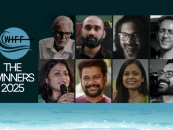
Do We Know What Our Children Want?
by Vinta Nanda November 14 2016, 6:09 pm Estimated Reading Time: 12 mins, 42 secs"There's always room for a story that can transport people to another place."
J.K. Rowling
Over the last one century or so, ordinary people like myself and many millions around the world have been banking on the penultimate hope when enduring the most unacceptable and withstanding the most painful, that by subsisting on the least of which is entitled to us and by persevering despite the erosion of our faith and trust in the systems that govern us; we are participating in building a better future for our children.
That is what has helped us survive repeated catastrophes and tragedies which have resulted from events mostly led by the politics of a tiny handful of people who make up the most powerful on earth, and in whom we have been repeatedly compelled to put our faith; and it is our resilience, optimism and our trust in the most elusive ‘better tomorrow’ which we seek, that has helped us sustain and rise again and again to recover from one injustice after another.
So, let’s stop for moment, take a pause and think.
Let us talk of the ‘now’, the present, and only about that future that we expect that we will be drawing from the actions that we are going to take today.
Let us at first admit that that the reason why we are politically weak is because we are a deeply divided world. Let us not make the mistake of saying that we are split on lines of color, caste, race, ethnicity, language, culture, region or ideologies; because by denying that it is economic differences that define us, we will lose the plot one more time.
Let us concede that we are divided because of the serious inequities that prevail and that economic disparities across the world are the consequence of alienation as well as the result of skewed distribution of rights and opportunities among the 7 billion or more people who inhabit our planet.
Let us accept that the deepest crevices that segregate humankind today are because of the indefensible concentration of wealth and resources of our world in 1% of the total population of the world.
“Pre-Davos report shows how 1% now own more than rest of us combined.”
Runaway inequality has created a world where 62 people own as much as the poorest half of the world's population, according to an Oxfam report published ahead of the annual gathering of the world's financial and political elites in Davos. This number has fallen dramatically from 388 as recently as 2010 and 80 last year.
An Economy for the 1% shows that the wealth of the poorest half of the world's population - that's 3.6 billion people - has fallen by a trillion dollars since 2010. This 38 per cent drop has occurred despite the global population increasing by around 400 million people during that period. Meanwhile the wealth of the richest 62 has increased by more than half a trillion dollars to $1.76tr. Just nine of the '62' are women.”
Read More : www.oxfam.org.uk
If something is not done to reverse this, then I’m afraid we are stepping into very difficult as well as dangerous times ahead.
But my intention is not to only discuss how we can turn the wheel and steer the broad story towards a more appropriate and acceptable direction.
It’s Children’s Day today in India and it also happens to be the first Prime Minister of Independent India’s, Jawahar Lal Nehru’s birthday, therefore it is about the rights of children who are the future of our world that we are going to talk about, and about how we can contextualize our young to the ongoing national socio-economic and political narrative.
V K Krishna Menon, who was an Indian nationalist, diplomat and statesman as well as a dear friend of Nehru, proposed the idea of Universal Children’s Day to the UN General Assembly and upon their acceptance this day was celebrated in October until 1959.
In 1959, November 20th was selected as the new day as it celebrated the anniversary of when the UN General Assembly adopted the “Declaration of the Rights of the Child”. Till date many countries celebrate Children’s Day on this day, India being an exception.
By the resolution passed on 14 December 1954, the General Assembly recommended that all countries institute a Universal Children’s Day, to be observed as a day of worldwide fraternity and understanding between children. It recommended that the Day be observed also as a day of activity devoted to promoting the ideals and objectives of the Charter and the welfare of the children of the world.
The Assembly suggested to governments that the Day be observed on the date and in the way which each considers appropriate. The date 20 November marks the day on which the Assembly adopted the Declaration of the Rights of the Child, in 1959, and the Convention on the Rights of the Child, in 1989.
The Convention, which is the most widely ratified international human rights treaty, sets out a number of children’s rights including the right to life, to health, to education and to play, as well as the right to family life, to be protected from violence, to not be discriminated, and to have their views heard.
It was after Nehru’s death in 1964, that India decided to celebrate Children’s Day or Baal Divas on the birth anniversary of the great leader, 14th November. Nehru, fondly referred to as Chacha Nehru (“Uncle Nehru”), dedicated a large portion of his life to the welfare of children across the nation.
Today India, with 1.21 billion people constitutes the second most populous country in the world, while children represent 39% of total population of the country. The figures show that the larger number of about 29 percent constitutes Children in the age between 0-5 years.
Source : Child Rights in India. Child in India Statistics and Children in India
Abduction, Emotional/Physical Abuse, Child Sexual Abuse, Crime, Domestic Violence, Dowry Harassment, Feticide and Infanticide, Human Rights Violations, Molestation, Murder, Rape, Street Harassment are suffered by many children who are unprotected by their communities because they are poor and backward, and many more children who belong to various other classes, cultures and regions in India.
Here below are some facts:
- 13,40,000 children below 5 die in a year, that is 3671 under 5 child deaths per day
- Nearly half of all child deaths under 5 in India are attributed to under nutrition
- 1 in every 11 children in India is working, when they should be at school
- More than half (56%) of the under 5 deaths occur within the first 28 days of life
- India accounts for more than 3 out of 10 stunted children in the world
- 47% of the women in India are married when they are a child (before the age of 18), and 30% bear a child when they are a child (adolescent mothers)
- 17.7 million children and adolescents are out of school in India, this is 14% of world’s population of children out of school
- 20% of grade 2 children in India cannot recognize numbers 1-9; 53% of children drop out of school at elementary level
- 49.5% of grade 5 children cannot do subtraction and 55% of grade 8 children cannot solve 3 digits by 1 digit division problem; 51.09% of grade 5 children cannot read grade 2 English and 25.4% children of grade 8 cannot read grade 2 text
Moreover UNICEF estimates that India with its larger population has the highest number of laborers in the world less than 14 years of age.
For much of human history and across different cultures, children less than 17 years old have contributed to family welfare in a variety of ways. UNICEF suggests that poverty is the big cause of child labor. The report also notes that in rural and impoverished parts of developing and undeveloped parts of the world, children have no real and meaningful alternative. Schools and teachers are unavailable. Child labor is the unnatural result.
A BBC report, similarly, concludes poverty and inadequate public education infrastructure are some of the causes of child labor in India.
Between boys and girls, UNICEF finds girls are two times more likely to be out of school and working in a domestic role. Parents with limited resources, claims UNICEF, should choose whose school costs and fees they can afford when a school is available. Educating girls tends to be a lower priority across the world, including India. Girls are also harassed or bullied at schools, sidelined by prejudice or poor curricula, per UNICEF. Solely by their gender, therefore, many girls are kept from school or drop out, then provide child labor.
Source: Save The Children (www.savethechildren.in)
I’m taking this discussion forward from the media and entertainment perspective hereon because it is important to note that technology and media play a key role in communication and dissemination of information in these dynamic times where innovation and discovery are placing the privileged and the entitled-on treadmills of recurring change and those left out from the ambit of the technology, media and entertainment orbit are being ruthlessly thrown on the side, which is frightening.
In India, those unaware of the global consciousness that technology provides and therefore those who at the receiving end of maybe just a trickle of development, comprise of almost 50% of our population.
All of them are poor.
Today television has the deepest penetration throughout India. Of the total TV universe of 674.5 million people (over 50% of India’s population), television reaches approximately 475 million people every day across the country. Compared to traditional media like print that reaches 282 million individuals, or radio that reaches 110 million, TV has a deeper reach.
TV is almost equally divided between urban and rural viewership’s. In fact, in absolute numbers, rural viewership is slightly higher at 343 million, while there are 331million urban viewers.
Digital India currently resides more in urban India with 246 million users, with nearly half of that number in rural India at 129 million. Unlike television where both male and female viewers are nearly equal, male internet users at 266 million are more than double of the 109 million female users.
In urban India, the reach of TV at 331million viewers is wider than digital at 246 million users. The rural equivalent is 343 million and 129 million respectively.
Smartphones are expected to grow from today’s 180 million users to 690 million by 2020.
Source: Media Penetration: A sneak into households by Partho Dasgupta http://blogs.economictimes.indiatimes.com/et-commentary/media-penetration-a-sneak-into-households/
So, let us make note of the fact that as per projections, even in the year 2020, our smart phone penetration in India will barely cover half the population of the country.
It is about time we realize that the penetration of television, digital technologies, Wi-Fi and mobile phones is almost directly proportional to the penetration of education, health services, social justice and political as well as economic growth. Governance might have reached everywhere and so must have information and communication technologies to most places, but it is important to understand that either the millions of people who are excluded from the race don’t have access or they cannot afford it.
Therefore, as the agencies of change and development organizations, our focus must be to reach the children of our excluded world, inform them and communicate to them, engage with them and interact with them in whichever way we can find, otherwise when they grow up to be adults in the next 10 years or so, they will be resentful as well as revengeful of the establishment and system.
“The stories we tell literally make the world. If you want to change the world, you need to change your story. This truth applies both to individuals and institutions.”
— Michael Margolis
At Asian Center for Entertainment Education (ACEE), we have been exploring the idea of using entertainment, which now proliferates roughly 65% of our populations through television, theatres as well as digital and mobile platforms, as an intervention for communicating with adolescents and as a tool for engaging with them in different parts of the country.
With our association with Dr Shravan Kumar, CEO CFSI, who has given vision to our partnership with his organization, and who has provided it with the momentum that it requires, we have successfully facilitated a partnership between CFSI and Cinepolis India (which has over 288 theatres across most States in India); to mainstream the most powerful and stimulating films that have been produced and which are being produced by CFSI at present.
This public-private partnership alone will soon be reaching its impressive line-up of emotionally poignant and inspiring films to over 400,000 excluded children, in the next one year itself.
And in this partnership that ACEE has forged with the CFSI (CFSI has 250 meaningful films most of which are created by stalwarts of the Indian Cinema industry over the last 50 years or so), we are aiming to reach the remaining 35% populations who are still outside the orbit of our entertainment distribution geographies, using films-on-wheels and several other non-formal methods.
In yet another partnership facilitated by ACEE between CFSI and the World Bank, Dr Shravan Kumar has lent his vision towards reaching out to the most excluded and marginalized children belonging to the poorest sections of society and to those children inhabiting the remotest parts of India, with the objective of enabling young children to express themselves by making their own films and by speaking about their aspirations and dreams to the rest of the nation through the medium.
While we understand that profits override decisions which go against them, it is important for us in the business of storytelling to understand the huge impact we can have on the children and youth who don’t have access to the entertainment we produce; therefore channeling meaningful, motivating and inspiring content through networks that belong to the Government and Non-Government sectors and reaching it to populations who do not own television sets, smart phones and/or don’t have seamless access to electricity and other basic services, will have far reaching effects and help accelerate the process of development.
If Devang Sampat of Cinepolis India, as well as my dear friend Lorena Guille, CSR Director at Cinepolis Foundation can commit to something that benefits the larger good by coming into a partnership with the Children’s Film Society of India and by giving a certain part of their profits a backseat, then there is no reason why all of the private sector of India cannot come into partnership with the public sector institutions which are relevant to it, go beyond the photo-ops and gloss and put a part of their returns aside once a year?
Why can’t every profitable company in India invest in creating the next generation of their customers who will bring back exponential returns on their investment in just a few years from now?
Come on India!
It’s time to get off the commercial carriage and it’s time to put our feet on the ground, so that children are no longer exploited and so that they can live a healthy and educated life far beyond the age of five.




-173X130.jpg)
-173X130.jpg)
-173X130.jpg)
-173X130.jpg)
-173X130.jpg)

-173X130.jpg)
